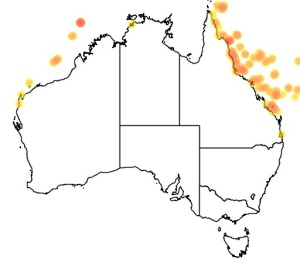Colours
Distinguishing features
A medium sized, dark brown fish which appears almost black underwater when viewed from a distance. Fine blue margins on dorsal, anal and tail fins. Pectoral fins uniformly dark, tail spines also dark. The only facial marking is a small orange spot behind the eye which may be indistinct. A white ring is often displayed around the tail base but this is not a distinguishing character.
Size
- Up to 40 cm (Standard length)
Depth range
- Depth range data is not yet available.
Synonyms
Similar taxa
-
Animalia:
Eyeline Surgeonfish (species: Acanthurus nigricauda)
has a long dark streak behind eye rather than a small orange spot, and has a yellow edge to pectoral fin. -
Animalia:
Inshore Surgeonfish (species: Acanthurus grammoptilus)
has small orange spots on the face and an orange streak through the eye. -
Animalia:
Ringtail Surgeonfish (species: Acanthurus auranticavus)
has fine stripes on body, a paler ring around the eye and an elongate dark marking behind the eye, outer edge of pectoral fin is yellowish, tail spines encircled with orange.
Distribution
Distribution and habitat preferences
Areas of turf algae and coral rubble on reef flats and slopes. Usually seen in schools.
Found in most reef habitats around the island, although most abundant on exposed reef fronts and nearby flats.
Behaviour
It is a roving herbivore, moving around the reef in schools and feeding on the fine turf algae. The surgeonfish are a very long lived group of fishes - after settlement to the reef, juveniles grow quickly and reach 80% of their maximum size in about 3 years, and then grow very slowly thereafter. Many of them live from 30-50 years. They spawn in groups during the warmer months, when fast running tidal currents coincide with dawn and dusk.
Web resources
Danger
- unspecified - There are a pair of poisonous bony knives at the base of the tail, which can be used to inflict a painful stabbing wound if the fish is handled.
References
- Brandl, S.J. and D.R. Bellwood (2013). Morphology, sociality, and ecology: can morphology predict pairing behavior in coral reef fishes? Coral Reefs, 32: 835-836. LIRS catalog number 1718.
- Brandl, S.J., W.D. Robbins and D.R. Bellwood (2015). Exploring the nature of ecological specialization in a coral reef fish community: morphology, diet and foraging microhabitat use, Proceedings of the Royal Society B, 282: 20151147, doi.org/10.1098/rspb.2015.1147. LIRS catalog number 1908.
- Ceccarelli, D.M., M.J. Emslie and Z.T. Richards (2016). Post-disturbance stability of fish assemblages measured at coarse taxonomic resolution masks change at finer scales. PLOS One, doi:10.1371/journal.pone.0156232. LIRS catalog number 1971.
- View all references




